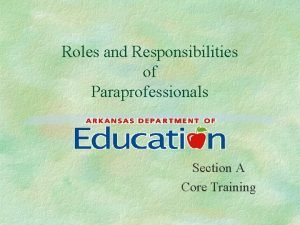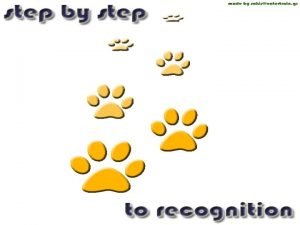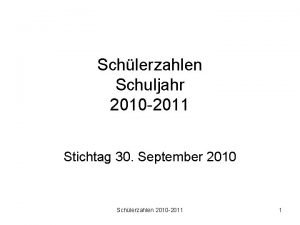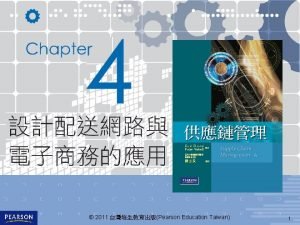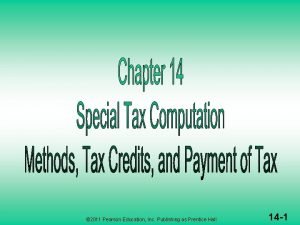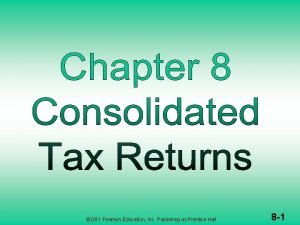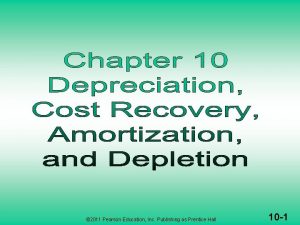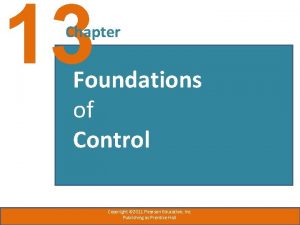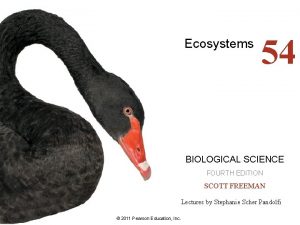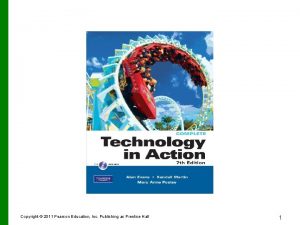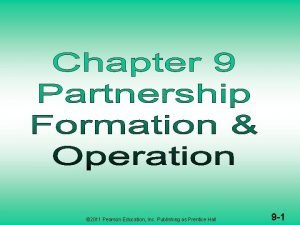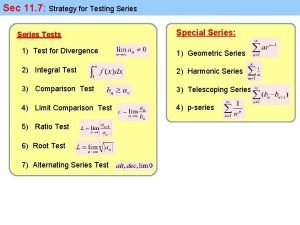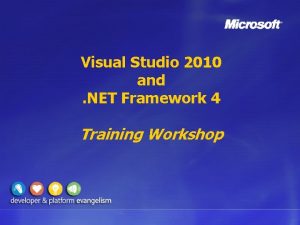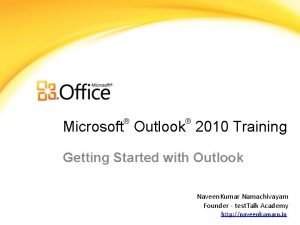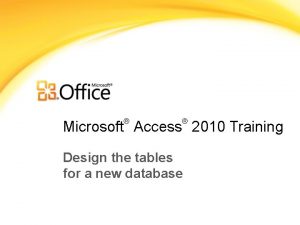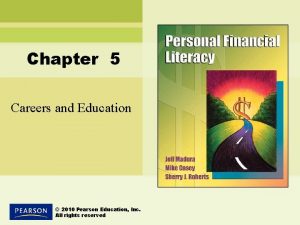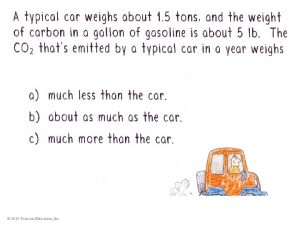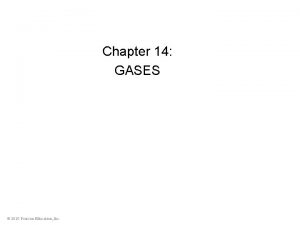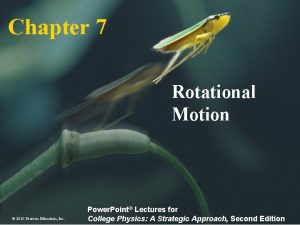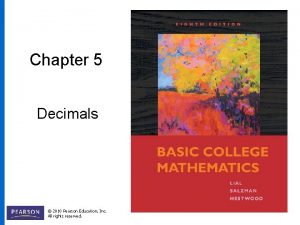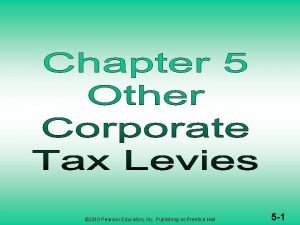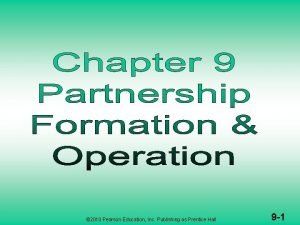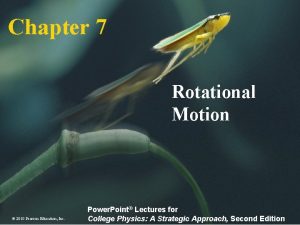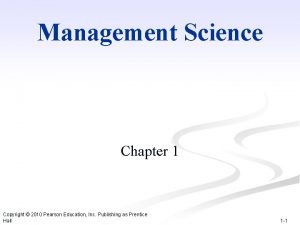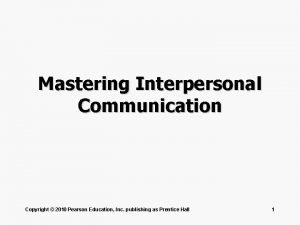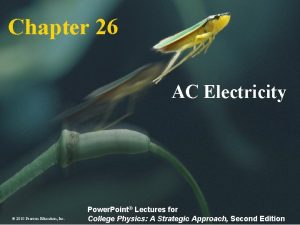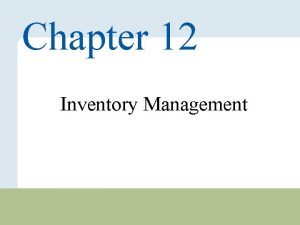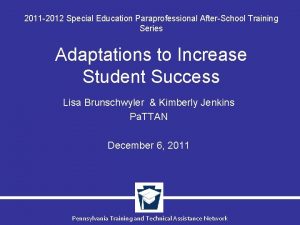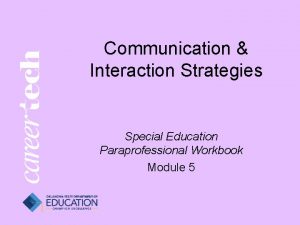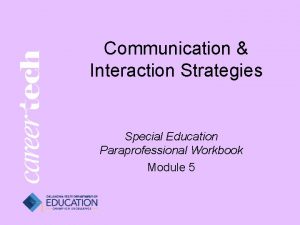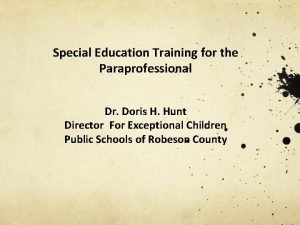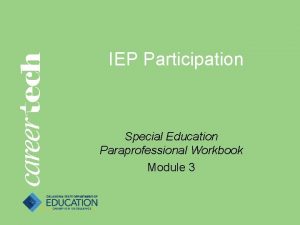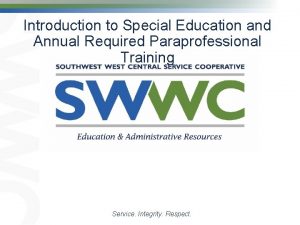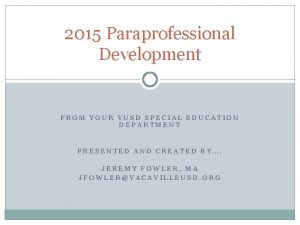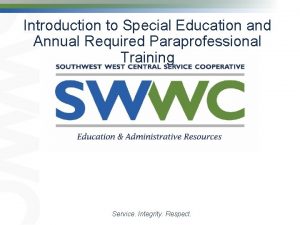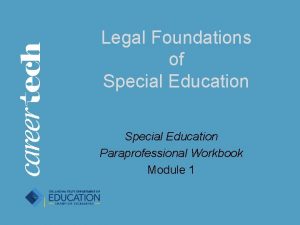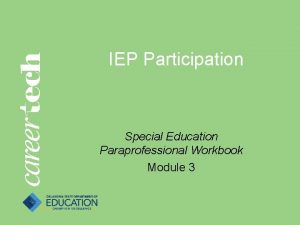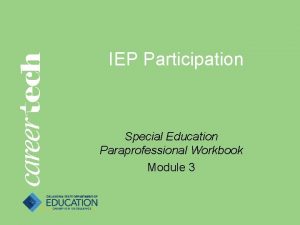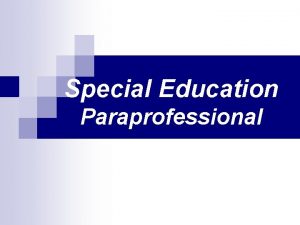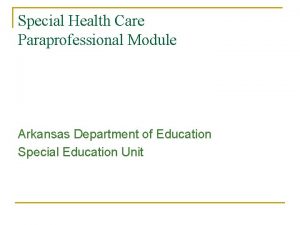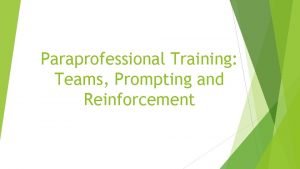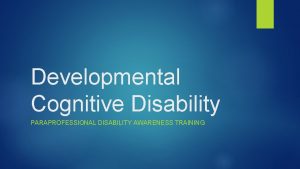2010 2011 Special Education Paraprofessional Training Series Strategies
































































- Slides: 64

2010 -2011 Special Education Paraprofessional Training Series Strategies for Diffusing Potential Behavior Problems March 8, 2011 Jane Brown Jennifer Goldbloom Pa. TTAN Pennsylvania Training and Technical Assistance Network

Pa. TTAN’s Mission The Pennsylvania Training and Technical Assistance Network is an initiative of the Pennsylvania Department of Education working in partnership with families and local education agencies to support programs and services to improve student learning and achievement.

PDE’s Commitment to Least Restrictive Environment (LRE) Our goal for each child is to ensure IEP teams begin with the general education setting with the use of supplementary aids and services before considering a more restrictive environment.

District, IU, Preschool Agency Policy Your local district or agency’s policies regarding paraprofessional job descriptions, duties, and responsibilities provide the final word!

Agenda • Introduction and learner outcomes • Basic behavior terms • Seven Phases of Challenging Behaviors • Scenarios • Wrap-up

Learner Outcomes Participants will: • Describe the range of behaviors encountered in their daily work • Examine a model that can help in recognizing signs that student behaviors may turn serious • Consider their role in preventing challenging behaviors from occurring • Explore effective strategies to use when challenging behaviors do occur



Think back… …to an interaction you had with a student that escalated into a confrontation or “meltdown. ” Alone, or with a partner, consider: – Was the outcome of that interaction what you expected? – How did you feel about the outcome? – If you could have a ‘do over’, would you do anything differently? 9

Basic Behavior Terms Antecedent what occurs before a behavior Behavior an observable and measurable act of an individual Consequence any event that follows a behavior Reinforcement Punishment

Basic Behavior Terms Function: the purpose that the behavior serves • to get something • to avoid, delay, or escape something Why Determine the Function?

Think of one of your students… Describe the student’s challenging behavior in observable, measurable terms:

Your Student Antecedent Behavior Consequence 14

My Student Antecedent difficult assignment, too long without break Behavior pushing, scratching, stamping feet Consequence disruption, work delay, injury, time-out, loss of privilege 15

Recognizing the Range of Behaviors What behaviors do you see? • Get into pairs or small groups • Choose a note taker • Brainstorm problem behaviors of students you encounter in your work • Place each behavior on the appropriate place on the Behavior Four-Square Chart (behavior can be in more than once place) • Share out

What “kind” of students display challenging behavior? All students. This is not a special education issue. It is an education issue.

Behavior Mantra “It is easier to prevent a behavior from occurring, than to deal with it after it has happened. ”

Reactive Approach to Behavior A B C 19

Proactive Approach to Behavior A B C 20

Behavior Support Assumptions • There is no place for ridicule or humiliation of children when managing behavior. • Inappropriate behavior is learned and predictable.

Behavior Support Assumptions • A student’s inappropriate behavior is not random or evil. • The instructor’s mere presence influences how students behave.

Seven Phases of Challenging Behaviors 5. Peak 4. Acceleration 6. De-escalation 3. Agitation 1. Calm 2. Trigger 7. Recovery Colvin (2004): Managing the Cycle of Acting-Out Behavior in the Classroom. Behavior Associates, Eugene, Oregon

Seven Phases of Challenging Behaviors 5. Peak 4. Acceleration Yo ua re he re 6. De-escalation 1. Calm 3. Agitation 2. Trigger 7. Recovery

Seven Phases of Challenging Behaviors 1. Calm Indicators: • Student is in typical, neutral state • Student is cooperative and responsive to teacher and task demands

Seven Phases of Challenging Behaviors 1. Calm To prevent unwanted behaviors: • Be aware of the antecedents that affect behavior ⁻ Environmental ⁻ Time ⁻ Physical/Medical ⁻ Task ⁻ Instructor ⁻ Presentation

Seven Phases of Challenging Behaviors 1. Calm To prevent unwanted behaviors: • Treat students with respect • Look for opportunities to praise students • Attend to appropriate behaviors of students

Seven Phases of Challenging Behaviors 5. Peak 4. Acceleration u Yo 6. De-escalation er eh ar 3. Agitation e 1. Calm 2. Trigger 7. Recovery

Seven Phases of Challenging Behaviors 2. Trigger Indicators: • Any event that provokes an undesired response from the student – School-based – Non-school based

Seven Phases of Challenging Behaviors 2. Trigger To prevent escalation: • Anticipate the trigger • Remove or reduce the importance of the trigger • Provide a reminder or cue for an alternate response to the trigger • Precision requests

Seven Phases of Challenging Behaviors 2. Trigger How to respond if behaviors occur: • Respond to negative student behaviors in a professional manner • Don’t take it personally • View as a teaching opportunity • Use pre-planned mild

Seven Phases of Challenging Behaviors 2. Trigger Do you find yourself saying… …I shouldn’t have to tell you …Everyone knows that …You should know better …I’ve told you this ? times before?

Seven Phases of Challenging Behaviors 2. Trigger Teach skills directly: • Problem-solving • Rehearsal • Social scripts • Relaxation techniques • Break card • Visual reminder cards http: //www. interventioncentral. org http: //www. behavioralinstitute. org

Seven Phases of Challenging Behaviors 2. Trigger How to respond if behaviors occur: Avoid Management Traps −Passionate discipline −Preaching −Questioning

Seven Phases of Challenging Behaviors 5. Peak u Yo 4. eh ar Acceleration er 6. De-escalation e 3. Agitation 1. Calm 2. Trigger 7. Recovery

Seven Phases of Challenging Behaviors 3. Agitation Indicators: • Student behavior unfocused or offtask • Student showing indicators of anxiety • Student no longer in typical, neutral state

Seven Phases of Challenging Behaviors 3. Agitation To prevent escalation: • Let student know you are aware there is a problem • Use active listening • Help student label the emotion • Clarify immediate expectations • Reduce situation demands

Seven Phases of Challenging Behaviors 3. Agitation To prevent escalation: • Provide or withdraw attention • Avoid a power struggle • Offer choices • Use interrupting strategies

Seven Phases of Challenging Behaviors 3. Agitation If this becomes a habit… • Set up accommodations in two phases: – Phase 1: offer the accommodation as needed – Phase 2: offer the accommodation, but student must make up the time or work that was missed 39

Seven Phases of Challenging Behaviors u Yo er eh ar 5. Peak e 4. Acceleration 6. De-escalation 3. Agitation 1. Calm 2. Trigger 7. Recovery

Seven Phases of Challenging Behaviors 4. Acceleration Indicators: • • Student actively resisting, refusing Verbal aggression, threats Violation of behavior rules A student screams “You can’t make me, _____” • A student curses at you • Behavior is confrontational

Seven Phases of Challenging Behaviors 4. Acceleration To prevent escalation: – Posture – Eye Contact – Facial Expression – Distance – Voice Quality – Privacy – Present Options – Acknowledge cooperation

Seven Phases of Challenging Behaviors 4. Acceleration How to respond if behaviors occur: • • • Avoid escalating prompts Remain calm and respectful Set clear limits Remove potentially dangerous items Obtain needed support to manage situation • Use distracting statements to help student redirect focus

Your Student Antecedent Behavior Consequence 44

My Student Antecedent Behavior difficult pushing, assignment, scratching, too long stamping feet without break chunk work, break card, take a break when needed – return to work, ask for help Consequence disruption, work delay, injury, time-out, loss of privilege acknowledge approp. beh. often, Allow alone time after 45

u Yo Seven Phases of Challenging Behaviors e er eh ar 5. Peak 4. Acceleration 6. De-escalation 3. Agitation 1. Calm 2. Trigger 7. Recovery

Seven Phases of Challenging Behaviors 5. Peak Indicators: • Student aggression to self, others or property • Overall student behavior out of control • Fighting • Assault

Seven Phases of Challenging Behaviors 5. Peak How to respond: • Specific Defusing Statements • Dignity for yourself • Dignity for the student • Keep the student in class • Teach an alternative to aggression

Seven Phases of Challenging Behaviors 5. Peak How to respond: • Protect yourself, student and others • Remove student or remove others • Pause and Assess • Physically step away and send for help • Block non-aggressively (if

Seven Phases of Challenging Behaviors 5. Peak 4. Acceleration u Yo e ar re he 6. De-escalation 3. Agitation 1. Calm 2. Trigger 7. Recovery

Seven Phases of Challenging Behaviors 6. De-escalation Indicators: • Reduction or cessation of student aggression • Reduced frequency or intensity of student behaviors • Student may appear confused

Seven Phases of Challenging Behaviors 6. De-escalation How to respond: • Be cautious of your responses • Provide cues to signal positive behaviors • Attend to appropriate behaviors • Engage student in individual assignment • Provide quiet time

Seven Phases of Challenging Behaviors 5. Peak 4. Acceleration 6. De-escalation 3. Agitation re u 1. Calm 2. Trigger Yo he e r a 7. Recovery

Seven Phases of Challenging Behaviors 7. Recovery Indicators: • Student returns to “calm” • Student eager to complete tasks • Student reluctant to interact or talk

Seven Phases of Challenging Behaviors 7. Recovery To prevent reoccurrence: • This is a necessary phase • Allow student time to regain composure

Seven Phases of Challenging Behaviors 7. Recovery How to respond: • Attend to appropriate student behaviors • Help student focus on independent task or activity • Debrief events that led to crisis • No negotiation of consequences • Teach alternative responses at a later

Seven Phases of Challenging Behaviors Additional Strategies • Disciplinary procedures • Short-term interventions • Long-term interventions • Complete exit paperwork • Implement Crisis Plan

Seven Phases of Challenging Behaviors Crisis Plan Development 1. Define the behaviors 2. Identify specific procedures 3. Consider staffing and support issues 4. Develop mechanisms for monitoring 5. Consider staff training 6. Plan for evaluation

Seven Phases of Challenging Behaviors Scenarios

Wrap-Up • Educators face challenges in dealing with student behavior • Student behaviors have multiple causes and multiple solutions • Staff behavior is a factor in the behavior chain • Use of diffusing strategies is a sensible and safe approach to problem behavior • We can defuse or we can escalate… The only behavior we can truly control


Learner Outcomes Participants will: • Describe the range of behaviors encountered in their daily work • Examine a model that can help in recognizing signs that student behaviors may turn serious • Consider their role in preventing challenging behaviors from occurring • Explore effective strategies to use when challenging behaviors do occur

Resources • Alderman, Gary L. Management Traps: Recognizing and Staying Out of Common Management Traps http: //www. ccbd. net/documents/bb/Fall_1997_Vol. 8_No. 3_Management_Traps. pdf • Colvin, Geoff, Ph. D. (1999) Defusing Anger and Aggression: Safe Strategies for Secondary School Educators. IRIS Media, Inc. , Eugene, Oregon. • Ginger Rhode, Ph. D. William R. Jenson, Ph. D. H. Kenton Reavis, Ed. D, (1992) The Tough Kid Book Sopris West

Resources • Mendler, Allen N. , Ph. D. (2005) Just in Time: Powerful Strategies to Promote Positive Behavior. National Education Service, Bloomington, Indiana. • Mendler, Allen N. , Ph. D. (1997) Power Struggles, Successful Techniques for Educators. Discipline Associates, Rochester, New York. • Walker, H. M. , Colvin, G. & Ramsey, E. (1995). Antisocial Behavior in School: Strategies and Best Practices. Pacific Grove, CA: Brooks/Cole Publishing Co.

Contact Information Jane Brown jabrown@pattan. net Jennifer Goldbloom jgoldbloom@pattan. net Commonwealth of Pennsylvania Tom Corbett, Governor Pennsylvania Department of Education Ronald J. Tomalis, Secretary Dr. Carolyn Dumaresq, Deputy Secretary Office of Elementary and Secondary Education John J. Tommasini, Director Bureau of Special Education Patricia Hozella, Assistant Director Bureau of Special Education
 Paraprofessional duties checklist
Paraprofessional duties checklist Education and training 2010
Education and training 2010 Education and training 2010
Education and training 2010 Schuljahr 2010/2011
Schuljahr 2010/2011 Pearson education 2011
Pearson education 2011 2011 pearson education inc
2011 pearson education inc 2011 pearson education inc
2011 pearson education inc 2011 pearson education inc
2011 pearson education inc 2011 pearson education inc
2011 pearson education inc 2011 pearson education inc
2011 pearson education inc 2011 pearson education inc
2011 pearson education inc 2011 pearson education inc
2011 pearson education inc 2011 pearson education inc
2011 pearson education inc 2011 pearson education inc
2011 pearson education inc Pearson education 2011
Pearson education 2011 2011 pearson education inc
2011 pearson education inc 2011 pearson education inc
2011 pearson education inc Pearson education 2011
Pearson education 2011 2011 pearson education inc biology
2011 pearson education inc biology 2011 pearson education inc
2011 pearson education inc 2011 pearson education inc biology
2011 pearson education inc biology 2011 pearson education inc
2011 pearson education inc 2011 pearson education inc
2011 pearson education inc Pearson education inc. publishing as prentice hall
Pearson education inc. publishing as prentice hall Strategies for testing series
Strategies for testing series Visual studio 2010 training
Visual studio 2010 training Microsoft outlook 2010 training
Microsoft outlook 2010 training Table design access
Table design access Excel 2010 training
Excel 2010 training Access 2010 training
Access 2010 training 2010 pearson education inc
2010 pearson education inc 2010 pearson education inc
2010 pearson education inc 2010 pearson education inc
2010 pearson education inc 2010 pearson education inc answers
2010 pearson education inc answers Educational policy 1998 to 2010
Educational policy 1998 to 2010 2010 pearson education inc answers
2010 pearson education inc answers 2010 pearson education inc answers
2010 pearson education inc answers 2010 pearson education inc
2010 pearson education inc 2010 pearson education inc
2010 pearson education inc Copyright 2010 pearson education inc
Copyright 2010 pearson education inc 2010 pearson education inc
2010 pearson education inc Copyright 2010 pearson education inc
Copyright 2010 pearson education inc 2010 pearson education inc answers
2010 pearson education inc answers 2010 pearson education inc answers
2010 pearson education inc answers 2010 pearson education inc
2010 pearson education inc Pearson education 2010
Pearson education 2010 2010 pearson education inc
2010 pearson education inc 2010 pearson education inc answers
2010 pearson education inc answers 2010 pearson education inc
2010 pearson education inc 2010 pearson education inc
2010 pearson education inc 2010 pearson education inc answers
2010 pearson education inc answers 2010 pearson education inc answers
2010 pearson education inc answers 2010 pearson education inc
2010 pearson education inc Copyright 2010 pearson education inc
Copyright 2010 pearson education inc Copyright 2010 pearson education inc
Copyright 2010 pearson education inc Copyright 2010 pearson education inc
Copyright 2010 pearson education inc Copyright 2010 pearson education inc
Copyright 2010 pearson education inc Copyright 2010 pearson education inc
Copyright 2010 pearson education inc Composition copyright example
Composition copyright example Pearson education inc all rights reserved
Pearson education inc all rights reserved 2010 pearson education inc
2010 pearson education inc 2010 pearson education inc answers
2010 pearson education inc answers Income statement pearson
Income statement pearson 2010 pearson education inc answers
2010 pearson education inc answers 2010 pearson education inc
2010 pearson education inc
